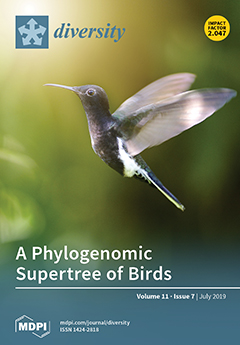Open AccessArticle
Seasonal Physiological Parameters and Phytotelmata Bacterial Diversity of Two Bromeliad Species (Aechmea gamosepala and Vriesea platynema) from the Atlantic Forest of Southern Brazil
by
Adriana Giongo, Renata Medina-Silva, Leandro V. Astarita, Luiz Gustavo dos A. Borges, Rafael R. Oliveira, Taiz L. L. Simão, Kelsey A. Gano, Austin G. Davis-Richardson, Christopher T. Brown, Jennie R. Fagen, Pedro M. Arzivenco, Calino P. Neto, André D. Abichequer, Catiéli G. Lindholz, Anelise Baptista-Silva, Claudio A. Mondin, Laura R. P. Utz, Eric W. Triplett and Eduardo Eizirik
Cited by 11 | Viewed by 4420
Abstract
The ecology of complex microhabitats remains poorly characterized in most tropical and subtropical biomes, and holds potential to help understand the structure and dynamics of different biodiversity components in these ecosystems. We assessed nutritional and metabolic parameters of two bromeliad species (
Aechmea
[...] Read more.
The ecology of complex microhabitats remains poorly characterized in most tropical and subtropical biomes, and holds potential to help understand the structure and dynamics of different biodiversity components in these ecosystems. We assessed nutritional and metabolic parameters of two bromeliad species (
Aechmea gamosepala and
Vriesea platynema) at an Atlantic Forest site and used 16S rDNA metabarcoding to survey the microbial communities inhabiting their tanks. We observed that levels of some nutrients (e.g., nitrogen) varied across seasons consistently in both species, while others (e.g., phenolic compounds) presented considerable differences between the two bromeliads. In contrast, patterns of tank microbial diversity did not follow a similar temporal trend. There was extensive variation in microbial composition among samples, which included intra-specific differences but also some consistent differences between the two bromeliads. For example,
Citrobacter,
Klebsiella and
Pantoea presented significantly different abundances in the two species. Interestingly, the dominant bacterial genera in both species included
Pseudomonas and
Enterobacter, which have been reported to include plant-beneficial species. Overall, our data contribute to the characterization of the nutritional status of Atlantic Forest bromeliads and the composition of their prokaryotic communities, laying the foundation for detailed investigations targeting the ecological interactions between these plants and their associated microbes.
Full article
►▼
Show Figures





